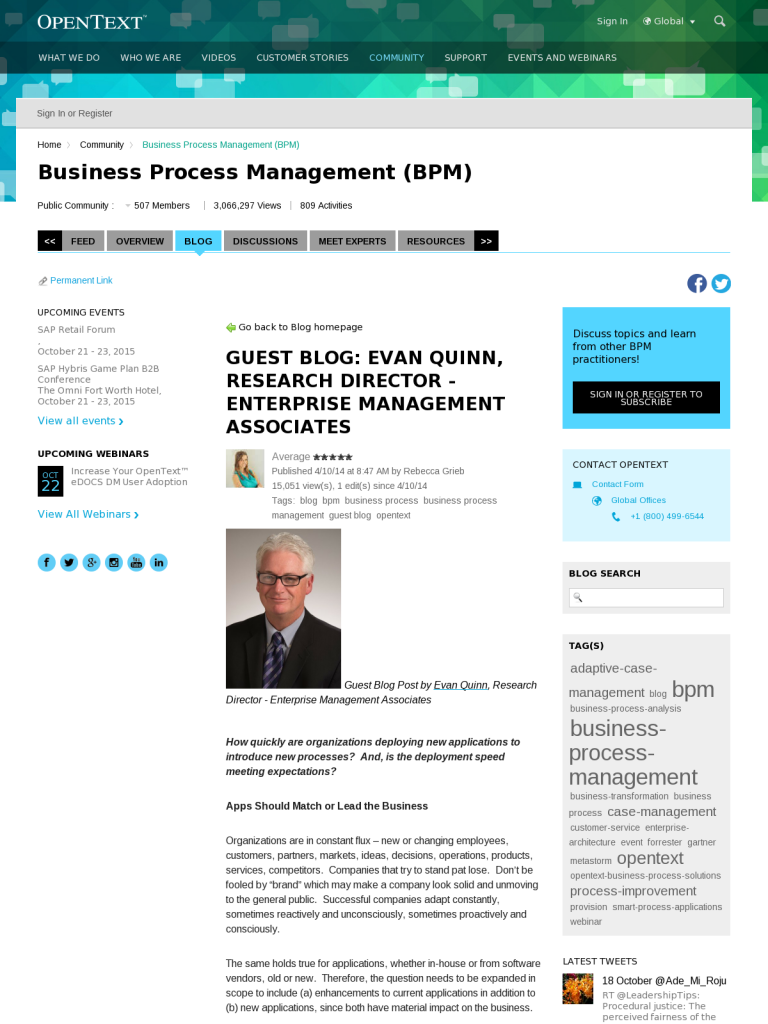Guest Blog: Evan Quinn, Research Director – Enterprise Management Associates
Blog: OpenText
Date:
Thu, 10 Apr 2014 08:47:00 GMT-05:00
From:
rgrieb
Guest Blog Post by Evan Quinn, Research
Director – Enterprise Management Associates
quickly are organizations deploying new applications to
introduce new processes? And, is the deployment speed meeting expectations?
Should Match or Lead the Business
are in constant flux – new or changing employees, customers,
partners, markets, ideas, decisions, operations, products, services,
competitors. Companies that try to stand pat lose. Don’t be fooled
by “brand” which may make a company look solid and unmoving to the
general public. Successful companies adapt constantly, sometimes
reactively and unconsciously, sometimes proactively and consciously.
same holds true for applications, whether in-house or from software
vendors, old or new. Therefore, the question needs to be expanded
in scope to include (a) enhancements to current applications in
addition to (b) new applications, since both have material impact on
the business.
that do not commit to ensuring their applications reflect business
change, preferably at the rate of business but optimally just ahead
of business, place a yoke around their ability to compete. What
good are applications if they are running behind the business? The
“automation” and “productivity” ROI of apps turns into a drag on
business performance when the apps loses touch.
CEOs, CIOs, and Line of Business executives that make keeping their
apps up to snuff a top priority, and that includes building new apps
if called for, are executing a winning formula. Organizations
should be constantly deploying new or enhanced apps, if they aren’t
something is amiss.
and iPaaS are the Answers
with a commitment to keeping apps on aligned with the business there
are only so many resources – analysts, developers, support staff,
budgets, and time are in limited supply. BPM in general, and the
concept of iPaaS in particular, integration Platform-as-a-Service,
offer a set of proven best practices and tools to help companies
keep up, and even pull ahead.
application that reflects important business processes that has not
been documented by BPM diagrams is like visiting a new country
without a map or GPS. Without that map of the processes and the
corresponding data, analysts and developers fly blind when
determining how to service new requirements, and when trying to
innovate. Without BPM, companies become dependent on local
knowledge stuffed in developers’ and analysts’ heads, and are at
risk when those experts find new jobs. Thus companies successfully
using BPM both avoid risk and enjoy reward.
next step after BPM, iPaaS, offers an opportunity to build new apps
out of existing, proven processes. Based on BPM, and rendered as
APIs, iPaaS helps analysts and developers quickly build and deploy
more innovative apps and process sets without reinventing the
process wheel each time. I like to call these “integrative
applications” because they typically reflect true, optimized,
complex business flows, rather than a restricted set of imagined
business processes.
-
Most
companies are in a constant state of change regarding business
processes, and should be. -
Applications,
old and new, should therefore also change to reflect the nature
of the business. Organizations, like it or not, are always
deploying new apps and enhancing old apps, or else their IT is
out of business alignment. -
BPM
is the best available set of tools and practices to add
reliability and speed to keeping apps in touch with the
business. -
iPaaS
offers a new layer on top of process integration to rapidly
build and deploy new apps to reflect optimized process flows,
adding productivity to developer and analyst work, and ensuring
better business outcomes.
that said, the business should never be satisfied with the speed of
new app development and app enhancement. IT should directly feel
and respond to, even ask for, the pressure that the business
feels.
Leave a Comment
You must be logged in to post a comment.








